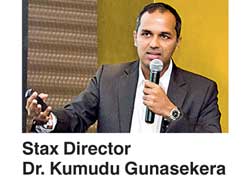Monday Apr 07, 2025
Monday Apr 07, 2025
Tuesday, 31 January 2017 00:01 - - {{hitsCtrl.values.hits}}
Stax, a global strategy consulting firm that advises leading private equity (PE) funds worldwide, noted that investment and merger and acquisition (M&A) activity in Sri Lanka has increased over the past two years.
An ongoing high level of activity is expected in t he near-term, mainly fuelled by continued interest in the country’s healthcare, hospitality, education, and export sectors.
he near-term, mainly fuelled by continued interest in the country’s healthcare, hospitality, education, and export sectors.
Stax noted that M&A trends in Sri Lanka mirror those in Asia—some of the largest PE deals in the region (within the past two years) have been in the B2B and healthcare space. For example, leading PE firms General Atlantic, Bain Capital, and Warburg Pincus acquired a stake in MedPlus Health services, a private healthcare player in India, for a value of $370M in 2015. Overall, M&A activity by PE firms within the Asian region saw an increase of 13% from 2015 to 2016.
Deal value sizes in Sri Lanka often do not match those within the broader region, as mature APAC economies are such dominant forces. However, there is still scope to attract smart investors to the island if local businesses “think big” and position themselves attractively as high-growth options.
“Sri Lanka is currently at an economic crossroad and the next few years are crucial. It has experienced stable GDP growth in the past and is expected to move to the upper middle income category by 2020. However, FDI inflows have decreased and the CSE is still not a mature exchange in comparison to heavyweights such as Singapore. A continued focus on hard infrastructure, increased emphasis on soft infrastructure, targeted trade promotion, and a renewed focus on an export-driven economy will be vital for Sri Lanka in attracting more investment capital,” noted Stax Director Dr. Kumudu Gunasekera.
Private secondary education, universities (foundation, pathway and degree programmes), and technical colleges are ripe for foreign investment, as there is increased spending on education, limited capacities at public universities and schools, and narrow study streams. Investors will also be eyeing earmarked export areas, which include knowledge-based exports (IT/BPO), and manufacturing-based wholesale and branded products.
“Healthcare investment in Sri Lanka generally focuses on developing infrastructure such as hospitals, wellness centres, laboratories, and institutes for medical tourism. However, there is also scope within services oriented to address healthcare needs. By 2030, one in every five Sri Lankans will be over the age of 60, and the 80+ cohort will account for over 5% of the country’s population by 2050. With the combination of rising incomes and ageing populations, we will see increased private healthcare expenditure,” added Dr. Gunasekera. “Aspects of hospitality such as support industries are also at a nascent stage and should be monitored for investment opportunities,” he concluded.
The next three to five years will be a window of opportunity in which local companies in healthcare, hospitality, education, and export industries can attract smart capital. With the right positioning and evidence of high growth, such players stand a good chance of capitalising on the PE interest in Sri Lanka.
Discover Kapruka, the leading online shopping platform in Sri Lanka, where you can conveniently send Gifts and Flowers to your loved ones for any event including Valentine ’s Day. Explore a wide range of popular Shopping Categories on Kapruka, including Toys, Groceries, Electronics, Birthday Cakes, Fruits, Chocolates, Flower Bouquets, Clothing, Watches, Lingerie, Gift Sets and Jewellery. Also if you’re interested in selling with Kapruka, Partner Central by Kapruka is the best solution to start with. Moreover, through Kapruka Global Shop, you can also enjoy the convenience of purchasing products from renowned platforms like Amazon and eBay and have them delivered to Sri Lanka.
Discover Kapruka, the leading online shopping platform in Sri Lanka, where you can conveniently send Gifts and Flowers to your loved ones for any event including Valentine ’s Day. Explore a wide range of popular Shopping Categories on Kapruka, including Toys, Groceries, Electronics, Birthday Cakes, Fruits, Chocolates, Flower Bouquets, Clothing, Watches, Lingerie, Gift Sets and Jewellery. Also if you’re interested in selling with Kapruka, Partner Central by Kapruka is the best solution to start with. Moreover, through Kapruka Global Shop, you can also enjoy the convenience of purchasing products from renowned platforms like Amazon and eBay and have them delivered to Sri Lanka.